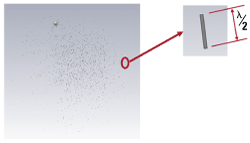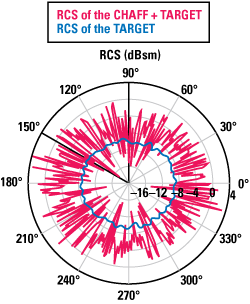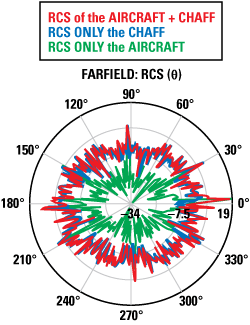A chaff cloud is made of metallic strips cut to obtain a resonant length. They are dispensed by a vehicle in the air to create a false signature in the enemy radar, masking the real vehicle return signal. Therefore, the detection and tracking become more complicated.
The impact of chaff has recently been reduced due to new technologies such as Doppler filters. However, chaff has been used with a high degree of success by misleading radar guided missiles. After launching a chaff cloud, the incoming missile tends to track on the chaff because of its higher RCS signature. The aircraft can then perform a fast, sharp maneuver, deviating from the missile path.
The issue of chaff cloud modeling has been addressed several times.1,4-6 Usually the RCS of a unitary strip is computed and later the statistics of a chaff cloud (that is normal or Gaussian distribution) are taken into consideration, in order to evaluate its global electromagnetic characteristics. Although the modeling is fast, since its computation relies on analytical formulae, it does not consider the coupling among adjacent strips and does not include the target in the scenario.
This work involves the modeling of a chaff cloud, with strips randomly distributed. It was computed with two different targets. The simulation is done with a 3D full wave electromagnetic simulator, using its Integral Equation Solver on a surface mesh.2 The results can provide much more realistic and conclusive results to address issues such as the necessary number of dipoles (the weight is a key issue in fighters), the frequency response of the strip and also the wind dispersion. Due to the intrinsic confidential status of these studies and the complicated actual measurements, the virtual evaluation is of vital importance.
Modeling Scheme
The first example considers a pure monochromatic radar wave of 10 GHz (X-band), which is a frequency commonly used by the missile radar. The strips are then cut to a half wavelength (which is equivalent to 15 mm). It is considered that the operational range of these strips is approximately 10 percent of the center frequency, in this case from 9.09 to 10 GHz.3 Common ways to achieve the operation in higher bandwidths and/or other frequency bands basically involve the use of strips of several lengths. The second example, due to its higher complexity, was simulated at 5 GHz (C-band).

Figure 1 Schematic of the VBA code to model the chaff cloud.
Since the number of individual strips is in the thousands, an automated modeling scheme is necessary. In this study, the integrated Visual Basic Interface (VBA) interpreter was used to create the chaff cloud automatically. Figure 1 illustrates the VBA code flowchart.
The main parameters used are:
- N = Number of Dipoles
- Translation set (tx, ty, tz) indicates the individual dipole translation distances
- Rotation set (rx, ry, rz) indicates the individual dipole rotation angles
- Only the number of dipoles (N) is set by the user; the other parameters are randomly set for each dipole.

Figure 2 Scenario of a metallic sphere and a chaff cloud.
Simulation Environment
Once the 3D model is ready, the electromagnetic conditions of the environment are set. Here the models are excited by a plane wave with a certain frequency to model the incoming wave from a radar transmitter placed in the far field, so that the electromagnetic wave can be considered plane (equal-phase condition).
The used solver is the Integral Equation (I). It uses a surface instead of a volumetric mesh, which means the problem becomes tractable with moderate computer resources. The I-solver possesses options where the problem can be solved with the iterative Method of Moments (MoM), or multilevel fast multipole method (MLFMM). The MLFMM uses a numerical scheme, where the original MoM matrix is manipulated to increase its sparseness, making the computation easier. It is suitable for situations where the number of elements and complexity are high. In the following sections two different cases are analyzed.

Figure 3 3D plot of the absolute RCS value for the sphere alone (a) and for the sphere and chaff cloud.
Case I: Chaff and a Metallic Sphere
The first case considers a metallic sphere as a target, with a diameter of 0.2 m (13.4 λ at 10 GHz) as depicted in Figure 2 where the zoomed area shows one metallic strip. The chaff cloud is made of 1800 resonant metallic strips. This problem is solved with the I-solver option called iterative MoM, since the number of variables is high but the overall complexity is not so critical. The incoming wave strikes the sphere after it goes through the chaff cloud, which means that the total scattering by a wave incident from a single direction is considered.

Figure 4 Monostatic RCS absolute value for the cases with and without the chaff cloud.
Figure 3 shows both the 3D plots of the absolute RCS for the cases with only the sphere and the sphere plus the chaff cloud. One clearly sees that the chaff creates several peaks where the RCS exceeds the normal sphere signature. Another option is the use of a monostatic RCS simulation. It simulates the structure being hit by a plane wave incident from different directions and it gets only the signal reflected back into the transmitter. It is a more realistic situation, where both the radar transmitter and receiver are in the same spatial position. The monostatic option offers an interesting feature, since it maintains the basis matrix for the different angles, enabling a faster computation. The monostatic (360° in steps of 1°) RCS polar plot is shown in Figure 4. From the figure, it is possible to see the chaff cloud effectóit creates several peaks of strong scattered signal, whereas the target alone has a more constant signature, with lower amplitude. Thus, the chaff cloud makes target detection much more complicated.

Figure 5 Scenario of an aircraft plus a launched chaff cloud both illuminate by a 5 GHz plane wave.

Figure 6 Comparison of the absolute values of RCS for three different situations at 5 GHz.
Case II: Chaff and a Fighter
This case involves a more realistic environment. It uses a fictitious aircraft (16 m long and wingspan of 14.5 m) hit by a plane wave at the frequency of 5 GHz. Although the frequency of interest is 10 GHz, the complete scenario with the plane was chosen for 5 GHz to make the simulation feasible with the available computer resources. The whole scenario took 32 hours in a Sun Fire X4600 machine with 2 AMD 2.8 GHz processors and a total RAM memory of 64 GB. The MLFMM solver was used, since the number of elements and the complexity were both high. The peak RAM used by the simulation was 46 GB. Figure 5 illustrates the problem. In the simulated case, the plane is detected by radar, modeled by a plane wave, which is positioned in the back of the plane.

Figure 7 Comparison of the absolute values of RCS for three different situations at 3 GHz.
The absolute RCS results for a 5 GHz plane wave are presented in Figure 6. Three different simulations were taken into account: the chaff alone, the aircraft alone and finally both together. It is possible to see that the chaff-only response has a much higher scattered electric field than that from the airplane. Therefore, the chaff cloud can, under these circumstances, be used to help an aircraft escape from a fired missile, even though the missile had already locked on the jet alone. Similar results for a 3 GHz plane wave can be seen in Figure 7. Since the strips are resonant at 5 GHz, the chaff cloud at 3 GHz is not so effective in comparison to the designed frequency. This is why strips of different lengths are used, covering a broader range of radar frequencies.
Conclusion
The full 3D electromagnetic modeling of a chaff cloud was undertaken to demonstrate that it is possible to simulate complicated and difficult real-world problems without simplifications. The chaff model was created using a VBA script and numerically simulated using commercial software. The strips were modeled as thin resonant metallic strips, randomly distributed. The results show that a complicated and difficult real-life problem can be analyzed without simplifications, in a relatively short time, using the Integral Equation solver. In this way, much more realistic and conclusive results can be derived to address issues such as the required number of dipoles, frequency response of the strips and also the wind dispersion. n
References
- F. Neri, Introduction to Electronic Defense Systems, Second Edition, Artech House Inc., Norwood, MA, 2001.
- CST MICROWAVE STUDIO® 2009, www.cst.com.
- G. Curry, Radar System Performance Modeling, Second Edition, Artech House Inc., Norwood, MA.
- C.L. Mack and B. Reiffen, "RF Characteristics of Thin Dipoles," Proceedings of the IEEE, Vol. 52, No. 5, May 1964, pp. 533-542.
- R.P. Fray, "Simulation of Chaff Cloud Signature," Master Thesis, Naval Postgraduate School, 1985.
- R.J. Garbacz, "Chaff Radar Cross Section Studies and Calculations," Technical Report, Ohio State University, 1978.
Marcelo Perotoni received his MsC and PhD degrees in electrical engineering from Sao Paulo University at 2001 and 2005, respectively. He spent one year at the University of Colorado in Boulder (2003) and was a post-doc at TUD (Tecnische Universitaet, Darmstadt) in 2006. He is currently an application and sales engineer at CST AG, based in Sao Paulo, Brazil.
Luiz Alberto de Andrade received his MsC and PhD degrees in astrophysics from the National Institute for Space Research (INPE) in 1999 and 2004, respectively. He is currently a researcher at the Space and Aeronautics Institute in Sao JosÈ dos Campos, Brazil.
Mirabel Cerqueira Rezende received her MsC degree in physical chemistry and her PhD degree in chemical engineering from Sao Paulo University in 1985 and 1991, respectively. She is currently an invited professor at the Air Force Institute of Technology and a senior researcher at the Space and Aeronautics Institute in Sao JosÈ dos Campos, Brazil.
Helcio Vieira Jr. earned his degree in aeronautics from the Air Force Academy and his MsC degree in production engineering from the State University of Rio de Janeiro (UFRJ) in 1991 and 2003, respectively. He is currently a PhD student at the Air Force Institute of Technology.
